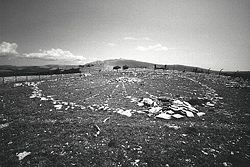Difference between revisions of "Template: Featured article 03 14" - New World Encyclopedia
From New World Encyclopedia
(Daily featured article from 2008 17) |
|||
| Line 1: | Line 1: | ||
{{Main page article box| | {{Main page article box| | ||
type=Featured| | type=Featured| | ||
| − | title= | + | title=Medicine wheel| |
| − | image_name= | + | image_name=bighorn medicine wheel.jpg| |
| − | image_desc= | + | image_desc=Medicine Wheel in Bighorn National Forest, Wyoming| |
| − | text=''' | + | text='''Medicine wheels''', or '''sacred hoops''', are [[stone structure]]s built by certain [[Indigenous peoples of the Americas]] apparently for [[astronomy|astronomical]], [[ritual]], healing, and [[teaching]] purposes. They were constructed by laying stones in a particular pattern on the ground. Most medicine wheels resemble a [[wagon]] [[wheel]], having a center [[cairn]] of stones surrounded by an outer ring of stones, and then "spokes," or lines of rocks, coming out from the cairn. The outer rings could be large, reaching diameters of as much as 75 feet. They were often constructed at or near the summit of a hill. |
| − | + | Medicine wheels are found in the prairie regions of [[Canada]] and the [[United States]], such as [[Alberta]], [[Manitoba]], [[Saskatchewan]], [[Wyoming]], and [[Montana]]. They were commonly used by the [[Ojibwa]] and [[Anishinaabe]] peoples, some structures dating back as much as 4,500 years. Some, such as the Bighorn Medicine Wheel, continue to be used by [[Native American]]s for religious ceremonies. | |
| + | |||
| + | While the original purpose of these stone structures is not known with certainty, they provide an intriguing link to the lives and culture of those who lived long ago. | ||
| + | }} | ||
Revision as of 15:21, 1 August 2017
Featured Article: Medicine wheel
Medicine wheels, or sacred hoops, are stone structures built by certain Indigenous peoples of the Americas apparently for astronomical, ritual, healing, and teaching purposes. They were constructed by laying stones in a particular pattern on the ground. Most medicine wheels resemble a wagon wheel, having a center cairn of stones surrounded by an outer ring of stones, and then "spokes," or lines of rocks, coming out from the cairn. The outer rings could be large, reaching diameters of as much as 75 feet. They were often constructed at or near the summit of a hill.
Medicine wheels are found in the prairie regions of Canada and the United States, such as Alberta, Manitoba, Saskatchewan, Wyoming, and Montana. They were commonly used by the Ojibwa and Anishinaabe peoples, some structures dating back as much as 4,500 years. Some, such as the Bighorn Medicine Wheel, continue to be used by Native Americans for religious ceremonies.
While the original purpose of these stone structures is not known with certainty, they provide an intriguing link to the lives and culture of those who lived long ago.